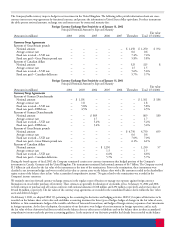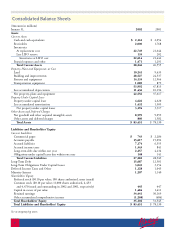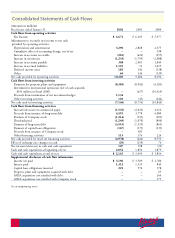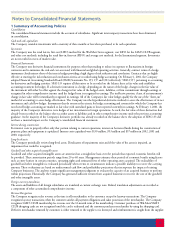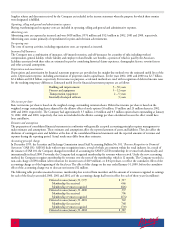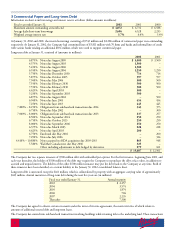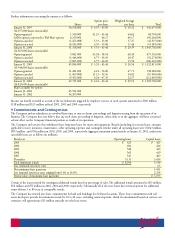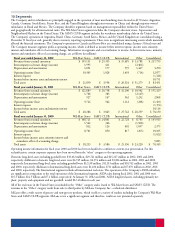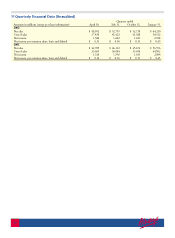Walmart 2002 Annual Report Download - page 31
Download and view the complete annual report
Please find page 31 of the 2002 Walmart annual report below. You can navigate through the pages in the report by either clicking on the pages listed below, or by using the keyword search tool below to find specific information within the annual report.
29
Supplier rebates and discounts received by the Company are included in the income statement when the purpose for which those monies
were designated is fulfilled.
Operating, selling and general and administrative expenses
Buying, warehousing and occupancy costs are included in operating, selling and general and administrative expenses.
Advertising costs
Advertising costs are expensed as incurred and were $618 million, $574 million and $523 million in 2002, 2001 and 2000, respectively.
Advertising costs consist primarily of expenditures for print and television advertisements.
Pre-opening costs
The costs of start-up activities, including organization costs, are expensed as incurred.
Insurance/Self-Insurance
The Company uses a combination of insurance, self-insured retention, and self-insurance for a number of risks including workers’
compensation, general liability, vehicle liability and employee related health care benefits, a portion of which is paid by the Associates.
Liabilities associated with these risks are estimated in part by considering historical claims experience, demographic factors, severity factors
and other actuarial assumptions.
Depreciation and amortization
Depreciation and amortization for financial statement purposes are provided on the straight-line method over the estimated useful lives of the
assets. Depreciation expense, including amortization of properties under capital leases, for the years 2002, 2001 and 2000 was $2.7 billion,
$2.4 billion and $2.0 billion, respectively. For income tax purposes, accelerated methods are used with recognition of deferred income taxes
for the resulting temporary differences. Estimated useful lives for financial statements purposes are as follows:
Building and improvements 5 – 50 years
Fixtures and equipment 5 – 12 years
Transportation equipment 2 – 5 years
Internally developed software 3 years
Net income per share
Basic net income per share is based on the weighted average outstanding common shares. Diluted net income per share is based on the
weighted average outstanding shares adjusted for the dilutive effect of stock options (16 million, 19 million and 23 million shares in 2002,
2001 and 2000, respectively). The Company had approximately 3.5 million, 2.0 million and 0.5 million option shares outstanding at January
31, 2002, 2001 and 2000, respectively, that were not included in the dilutive earnings per share calculation because the effect would have
been antidilutive.
Estimates and assumptions
The preparation of consolidated financial statements in conformity with generally accepted accounting principles requires management to
make estimates and assumptions. These estimates and assumptions affect the reported amounts of assets and liabilities. They also affect the
disclosure of contingent assets and liabilities at the date of the consolidated financial statements and the reported amounts of revenues and
expenses during the reporting period. Actual results may differ from these estimates.
Accounting principle change
In December 1999, the Securities and Exchange Commission issued Staff Accounting Bulletin No. 101, “Revenue Recognition in Financial
Statements” (SAB 101). SAB 101 dealt with revenue recognition issues, several of which are common within the retail industry. As a result of
the issuance of SAB 101, the Company changed its method of accounting for SAM’S CLUB membership fee revenue both domestically and
internationally in fiscal 2000. Previously, the Company had recognized membership fee revenues when received. Under the new accounting
method, the Company recognizes membership fee revenues over the term of the membership, which is 12 months. The Company recorded a
non-cash charge of $198 million (after reduction for income taxes of $119 million), or $.04 per share, to reflect the cumulative effect of the
accounting change as of the beginning of the fiscal year. The effect of this change on the year ended January 31, 2000, before the cumulative
effect of the accounting change was to decrease net income $12 million.
The following table provides unearned revenues, membership fees received from members and the amount of revenues recognized in earnings
for each of the fiscal years ended 2000, 2001 and 2002 as if the accounting change had been in effect for each of those years (in millions):
Deferred revenue January 31, 1999 $ 317
Membership fees received 646
Membership revenue recognized (626)
Deferred revenue January 31, 2000 337
Membership fees received 706
Membership revenue recognized (674)
Deferred revenue January 31, 2001 369
Membership fees received 748
Membership revenue recognized (730)
Deferred revenue January 31, 2002 $ 387





